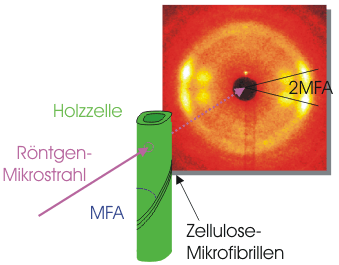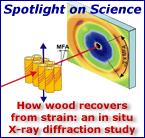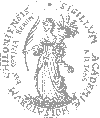|
The research group "Physics of Biological Composite Materials" at the Institute for Experimental and Applied Physics at Kiel University
studies structured biological materials, in particular wood and natural cellulose fibers such as for example flax.
In this interdiscplinary field we cooperate with physicists, materials scientists, biologists, chemists and wood researchers
(see collaboration).
Wood is an extraordinary material, it combines high firmness with low density.
These unique mechanical properties are caused by the micro- and nano-structure [52].
Cellulose fibers and wood are hierarchically ordered biomaterials.
They have the propoerties of a compound, since they are built of "hard" cellulose crystals (microfibrils).
(length some μm, diameter 2--20 nm), which are embedded in a soft matrix.
The microfibrils lie parallel to each other and build a helix, that runs around the fiber or wood cell (s. Fig. 1).
The angle, which this helix spans in respect to the middle of the cell axis (microfibril angle, MFA) is important for the mechanical properties of fibers or wood.
X-ray scattering with microscopic spatial resolution yields information on a length scale from the unit cell of cellulose crystals up to variation of the MFA
iside the cell wall (Fig.1).
[12,
19,
21,
26,
28,
29,
30,
31,
41,
43,
48
52
53
55].
Interesting results can also be obtained on the biosnthesis of cellulose [41,
44].

Schematic buildup of a wood cell and principle of MFA-determination
in a X-ray microbeam scattering experiment at a synchrotron.
This first step, the characterisation of structure and morphology, is followed by the determination of the resulting
mechanical properties (elastic modulus, maximal extension). Stretching experiments with instrumnets that were developped in Kiel
were already successfully in situ combined with Y-ray scattering. In this context especially the influence of
water is studied by varying the moisture content.
ESRF Spotlight on the deformation mechanism of wood; see also publication [52].

The aim of this project is to develop a model for cellulose fibers and for the natural nanocomposite wood.
The insights can contribute to the design of new materials.
The properties of a composite are very much dependant of the matrix, in which the hard components are embedded.
In the case of cellulose fibers this task is taken on by the unordered cellulose that surrounds the microfibrils. Inelastic neutron scattering
is very sensitive to the local properties of molecules. With this method the universality of the unordered
areas of natural cellulose could be proven [27]. Also the preferred orientation of the unordered cellulose molecules
in the direction of the fibers could be shown by INS.
Based on our studies on this topic [20,
32,
33]
we anticipate very interesting results on supercooling of water,
as it is found in proteins. X-ray and neutron scattering allows precise studying supercooled water and
new amorphous phases of ice in respect to strcutre and dynamics. Again especially the
inelastic neutron scattering turns out ot be an ideal probe, with which the supercooling of water bound to cellulose down to
200 K could be proven [32].
As coopted member of the German Committee Research with Neutrons "Komitee Forschung mit Neutronen" (KFN) and head of the department
"User Support and Outreac" Prof. Dr. Müller leads a project which aims at improving the presentation of neutrons research in the public
The first result is the new webpage of the KFN at
http://www.neutronenforschung.de.
|
|

